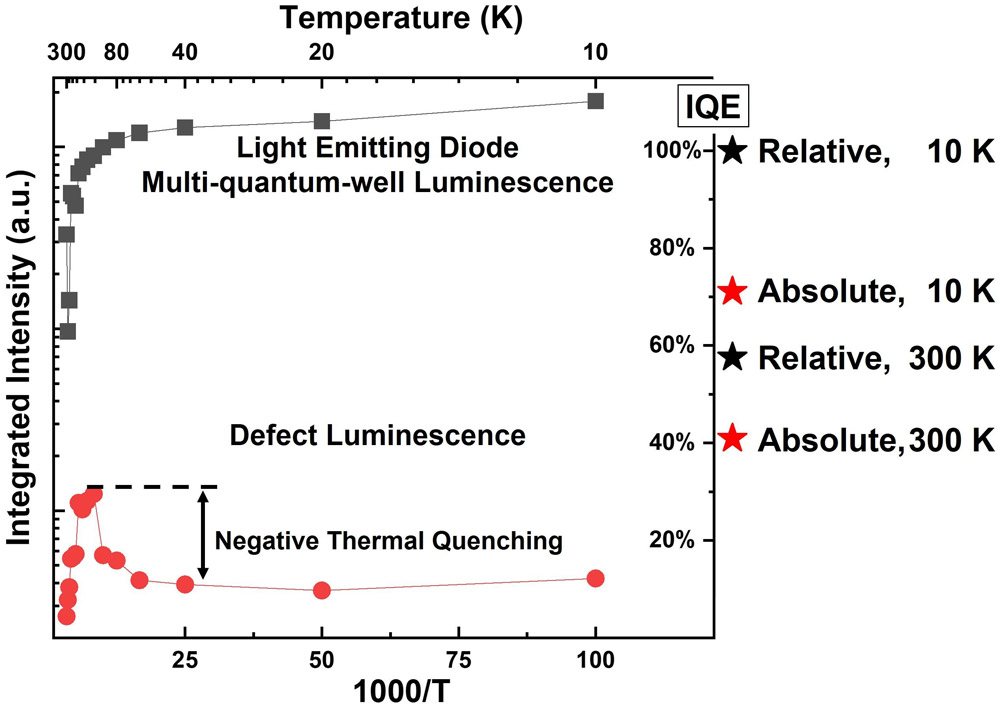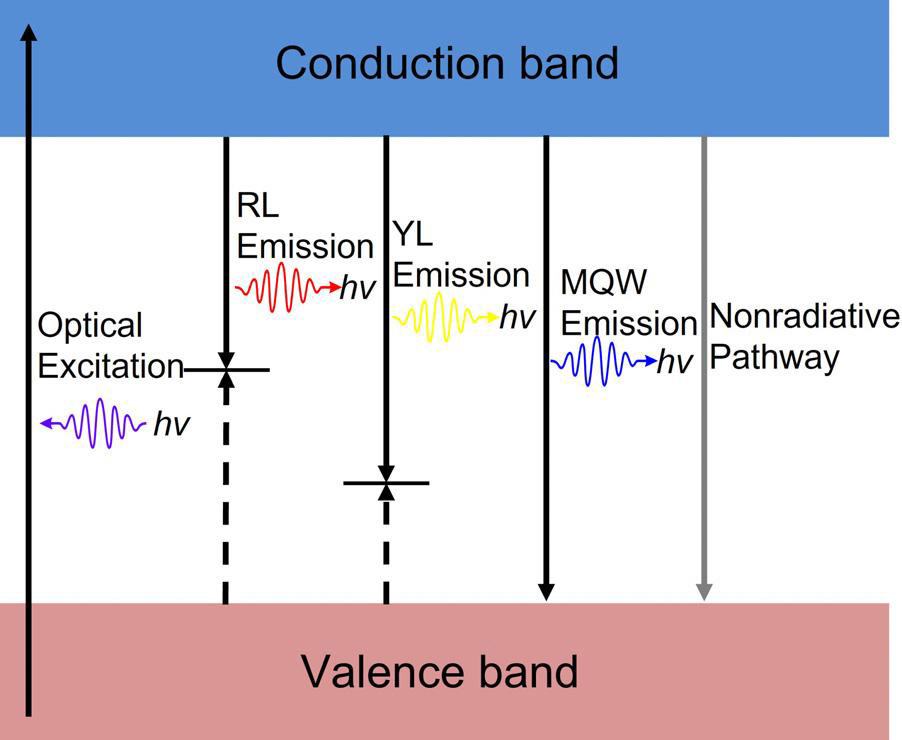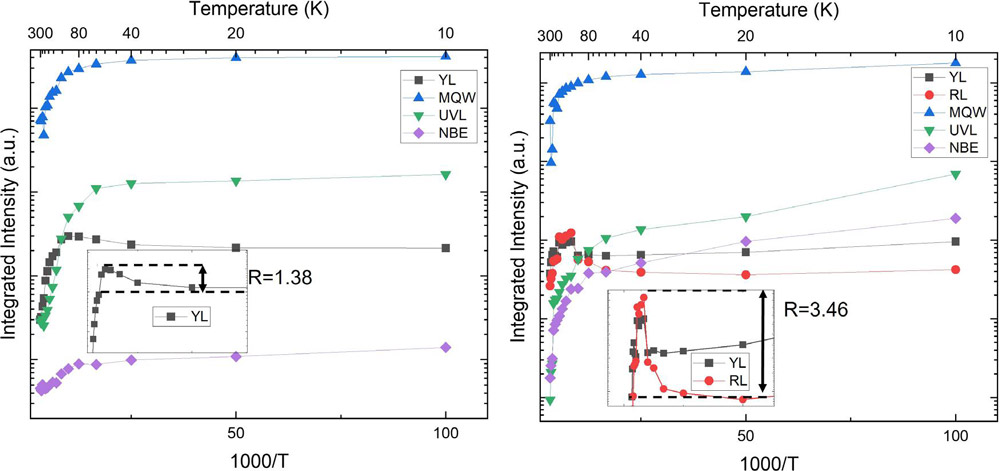News: LEDs
29 March 2023
Re-assessing internal quantum efficiency assumptions
YC Chiu and C Bayram of University of Illinois at Urbana-Champaign in the USA have presented measurements that question the usual assumption that internal quantum efficiencies (IQEs) of light-emitting diode (LED) structures are close to 100% at low temperature [Appl. Phys. Lett., v122, p091101, 2023].

Figure 1: Impact of estimating absolute IQE from low-temperature value. Relative IQEs: 100% at 10K and 58% at 300K. Absolute IQEs: 71% at 10K, 41% at 300K. One would point out that high temperature is to left of graphs here (and below).
IQEs at room temperature (~300K) are often estimated (Figure 1) based on photoluminescence experiments that compare the emission intensity with that at low temperature (~10K). These IQEs are then used to estimate other factors such as light extraction efficiency etc.
Not being able to adequately track down the blockages toward higher-efficiency devices could slow progress to more sustainable and comfortable societies around the world that can meet the challenge of climate instability brought on by higher carbon dioxide (CO2) and other greenhouse gas levels.
Chiu and Bayram write: “Continual efficiency improvements in LEDs are needed per the DOE 2035 roadmap, which sees the blue LED efficiencies increase from 70% to 90% and furthering energy and CO2 emission savings by 450TWh and 154 million metric tons, respectively.”
Chiu and Bayram considered the emissions from multiple quantum well (MQWs) from photon excitation of valence electrons to the conduction band and subsequent relaxation as occurring through four channels: red (RL) and yellow (YL) luminescence, nonradiative, and the desired 2.79eV MQW emission from electron recombination with holes in the valence band (Figure 2). The RL and YL channels proceed through mid-gap defect levels, and are less energetic than the MQW emission, hence the different colors.

Figure 2: Representative band diagram of recombination within MQWs from optical excitation by laser (hν ~ 4.66eV, λ ~ 266nm) through three luminescent recombination pathways, and non-radiative recombination.
In photoluminescence experiments there are also ultraviolet luminescence (UVL) and near-band-edge (NBE) emissions, but these are not included in considerations of the IQE of MQW structures, although they do affect external quantum efficiency and wall-plug efficiency.
Since the non-radiative recombination is effectively invisible to photoluminescence detectors, the researchers had to extract estimates of the low-temperature IQE from considering the variations of the visible emissions with temperature. In particular, they studied the negative thermal quenching (NTQ) of the RL and YL channels (Figure 3). TQ describes a decrease in emission with temperature, while NTQ occurs with an increase in luminescence through a channel.

Figure 3: Integrated photoluminescent intensities of different luminescent bands of LEDs on sapphire (left) and Si (111) (right) as function of temperature. Insets: zoom-in on NTQ regions of defect luminescence bands of LED layers on sapphire (YL) and silicon (YL and RL).
The estimates were based on the work of Michael A. Reshchikov of Virginia Commonwealth University and Roman Y. Korotkov of Northwestern University in the USA, which relates the low-temperature IQE to the amount of NTQ in defect-related emission channels. For LED epitaxial layers on sapphire the NTQ ratio (R) reached 1.38x the low-temperature intensity for YL, while it reached 3.46x for a similar structure on Si(111). The low-temperature IQE is estimated by (R-1)/R: 27.5% on sapphire and 71.1% on Si(111). These values are clearly far from the usual assumption of 100% IQE.
Chiu and Bayram comment: “If the PL quenching mechanism of a highly luminescent channel is of the type first proposed by Reshchikov, which involves multiple recombination pathways, negative thermal quenching could be observed in channels that are not simultaneously quenched (i.e. have different quenching temperatures).”
Studies of the excitation-power dependence of the emissions at 10K and 300K (room temperature) were consistent with the LED/sapphire wafer having higher defect density and hence lower IQE, relative to that on silicon substrate. Also, materials analyses showed that the sapphire-based structure had 1.57nm surface roughness and 6.3x109/cm2 defect density, compared with 1.45nm and 5.4x108/cm2 for the LED layers on silicon. The sapphire wafer also had higher compressive stress in the LED layers.
Chiu and Bayram comment: “These findings suggest that reducing the defect density and lowering the compressive stress in LEDs are essential for high-efficiency LEDs.”
https://doi.org/10.1063/5.0142701
The author Mike Cooke is a freelance technology journalist who has worked in the semiconductor and advanced technology sectors since 1997.








